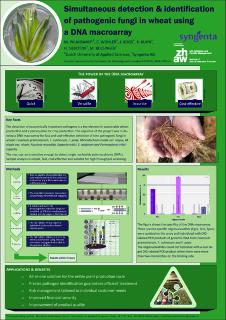Please use this identifier to cite or link to this item:
https://doi.org/10.21256/zhaw-4291| Publication type: | Conference poster |
| Type of review: | Not specified |
| Title: | Simultaneous detection and identification of pathogenic fungi in wheat using a DNA macroarray |
| Authors: | Palmisano, Marilena Wohler, Christian Boos, Jürg Kuhn, Roger Sierotzki, H. Bolsinger, M. |
| DOI: | 10.21256/zhaw-4291 |
| Proceedings: | Book of Abstracts: 2nd Symposium on Horticulture in Europe - SHE 2012 |
| Page(s): | 171 |
| Conference details: | 2nd Symposium on Horticulture in Europe, Angers, 1-5 July 2012 |
| Issue Date: | 2012 |
| Publisher / Ed. Institution: | ZHAW Zürcher Hochschule für Angewandte Wissenschaften |
| Language: | English |
| Subjects: | IUNR; SPEZI; ZHO |
| Subject (DDC): | 572: Biochemistry 580: Plants (Botany) |
| Abstract: | The detection of economically important pathogens is a key element in sustainable wheat production and a prerequisite for crop protection. The objective of the project was to develop a DNA macroarray for fast and cost-effective detection of nine pathogenic fungi in wheat: Fusarium graminearum, Fusarium culmorum, Fusarium poae, Microdochium nivale var. majus, Microdochium nivale var. nivale, Puccinia recondita, Septoria tritici, Septoria nodorum and Pyrenophora tritici-repentis. Methodically, a macroarray is similar to a microarray but without the need for expensive equipment. PCR labelled samples of DNA are hybridized to pathogen-specific oligonucleotides (probes) anchored to a solid support. A positive reaction between an amplicon and a perfectly matched oligonucleotide generates a chemiluminescent signal which can be detected by a plate reader. The macroarray is sensitive enough to detect single nucleotide polymorphism (SNPs). Sample analysis is simple, fast, cost-effective, fully automated and suitable for high throughput screening. In this project, the nine wheat pathogens were detected within 6 hours simultaneously in a single sample using between one to four different species-specific probes for each pathogen. Species-specific detector oligonucleotides were designed based on the β-tubulin and/or succinate dehydrogenase region of fungal DNA. The detection limit of the DNA macroarray technique particularly depends on the pathogen-specific oligonucleotides deployed. The necessity for monitoring pathogenic fungi in wheat production and for prediction of crop yield has been recognized for a long time. The DNA macroarray responds very sensitively and has the potential to recognize pathogenic fungi earlier with reference to the cultivation period than a conventional PCR. This means that the DNA macroarray can detect genomic DNA from fungi in a lower potency than the conventional PCR. One benefit of the DNA macroarray for detection of fungal pathogens in wheat is its increased specificity and the other its application to a large number of microorganisms which can be detected in a single assay. This technology has been proven to be relatively cost-effective compared with real-time PCR or microarrays. This project was financially supported by the Commission of Technology and Innovation CTI in Berne, Switzerland. |
| URI: | https://digitalcollection.zhaw.ch/handle/11475/8438 |
| Fulltext version: | Published version |
| License (according to publishing contract): | Licence according to publishing contract |
| Departement: | Life Sciences and Facility Management |
| Organisational Unit: | Institute of Natural Resource Sciences (IUNR) |
| Appears in collections: | Publikationen Life Sciences und Facility Management |
Files in This Item:
| File | Description | Size | Format | |
|---|---|---|---|---|
| 202750.pdf | Poster | 2.9 MB | Adobe PDF |  View/Open |
Show full item record
Palmisano, M., Wohler, C., Boos, J., Kuhn, R., Sierotzki, H., & Bolsinger, M. (2012). Simultaneous detection and identification of pathogenic fungi in wheat using a DNA macroarray [Conference poster]. Book of Abstracts: 2nd Symposium on Horticulture in Europe - SHE 2012, 171. https://doi.org/10.21256/zhaw-4291
Palmisano, M. et al. (2012) ‘Simultaneous detection and identification of pathogenic fungi in wheat using a DNA macroarray’, in Book of Abstracts: 2nd Symposium on Horticulture in Europe - SHE 2012. ZHAW Zürcher Hochschule für Angewandte Wissenschaften, p. 171. Available at: https://doi.org/10.21256/zhaw-4291.
M. Palmisano, C. Wohler, J. Boos, R. Kuhn, H. Sierotzki, and M. Bolsinger, “Simultaneous detection and identification of pathogenic fungi in wheat using a DNA macroarray,” in Book of Abstracts: 2nd Symposium on Horticulture in Europe - SHE 2012, 2012, p. 171. doi: 10.21256/zhaw-4291.
PALMISANO, Marilena, Christian WOHLER, Jürg BOOS, Roger KUHN, H. SIEROTZKI und M. BOLSINGER, 2012. Simultaneous detection and identification of pathogenic fungi in wheat using a DNA macroarray. In: Book of Abstracts: 2nd Symposium on Horticulture in Europe - SHE 2012. Conference poster. ZHAW Zürcher Hochschule für Angewandte Wissenschaften. 2012. S. 171
Palmisano, Marilena, Christian Wohler, Jürg Boos, Roger Kuhn, H. Sierotzki, and M. Bolsinger. 2012. “Simultaneous Detection and Identification of Pathogenic Fungi in Wheat Using a DNA Macroarray.” Conference poster. In Book of Abstracts: 2nd Symposium on Horticulture in Europe - SHE 2012, 171. ZHAW Zürcher Hochschule für Angewandte Wissenschaften. https://doi.org/10.21256/zhaw-4291.
Palmisano, Marilena, et al. “Simultaneous Detection and Identification of Pathogenic Fungi in Wheat Using a DNA Macroarray.” Book of Abstracts: 2nd Symposium on Horticulture in Europe - SHE 2012, ZHAW Zürcher Hochschule für Angewandte Wissenschaften, 2012, p. 171, https://doi.org/10.21256/zhaw-4291.
Items in DSpace are protected by copyright, with all rights reserved, unless otherwise indicated.